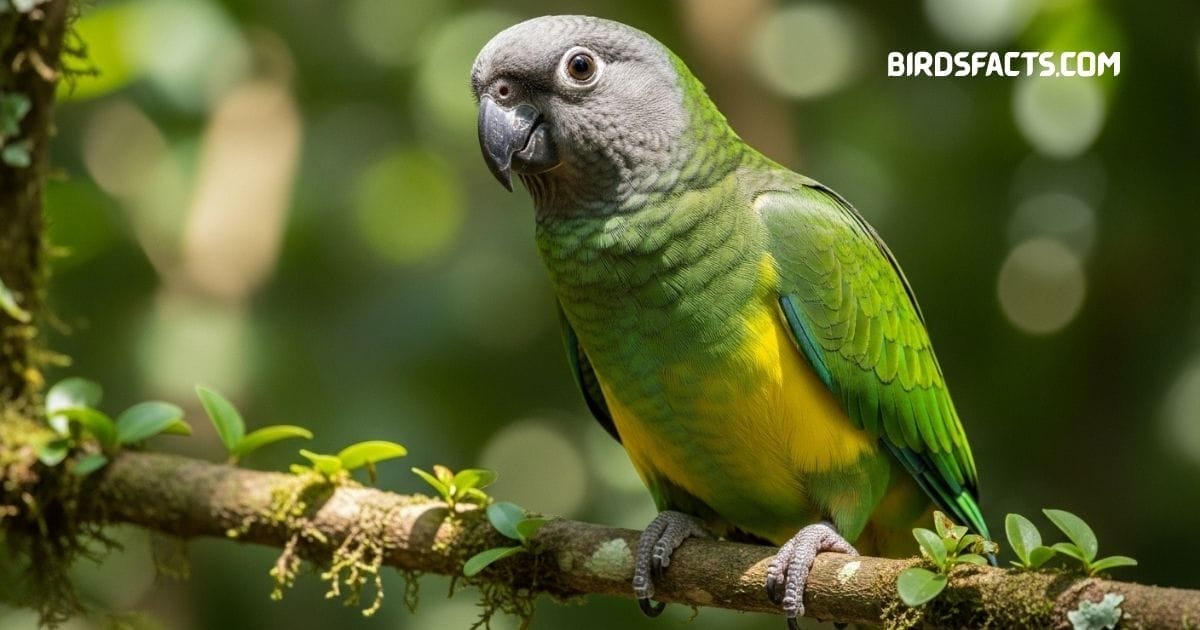
Green Birds
Have You Ever Spotted A Flash Of Bright Green Birds Wings And Wondered What Bird It Was. I Know The Feeling. It Can Be Frustrating When You Are Curious About Nature But Do Not Know The Names Or Stories Behind The Creatures You See. That Is Usually How People Get Hooked On Learning About Green Birds. They Stand Out And Spark Instant Curiosity.
The Truth Is These Birds Are Not Just Beautiful To Look At. They Are Also Full Of Fascinating Traits And Cultural Meanings. From Tiny Humming Birds To Parrots With Bold Personalities. Green Birds Are Found In Forests Gardens And Even Back Yards Around The World. Once You Learn A Little About Them You Will Never Look At That Quick Green Blur The Same Way Again.
Green Birds
- Asian Green Bee-eater
- Blue-Fronted Amazon
- Budgie
- Blue-Crowned Conure
- Conure
- Canary-Winged Parakeet
- Double Yellow-Headed Amazon Parrot
- Eclectus
- Fischer’s Lovebird
- Glistening-green Tanager
- Great Green Macaw
- Green Jay
- Green-breasted Mango
- Green Parakeet
- Grass-green Tanager
- Green Heron
- Green-Cheeked Conure
- Lineolated Parakeet
- Meyer’s Parrot
- Northern Emerald-Toucanet
- Psittacula
- Pionus Parrot
- Poicephalus
- Parrotlet
- Rosy-Faced Lovebird
- Senegal Parrot
- White-eyed Parakeet
- Yellow-Naped Amazon Parrot
Asian Green Bee-eater
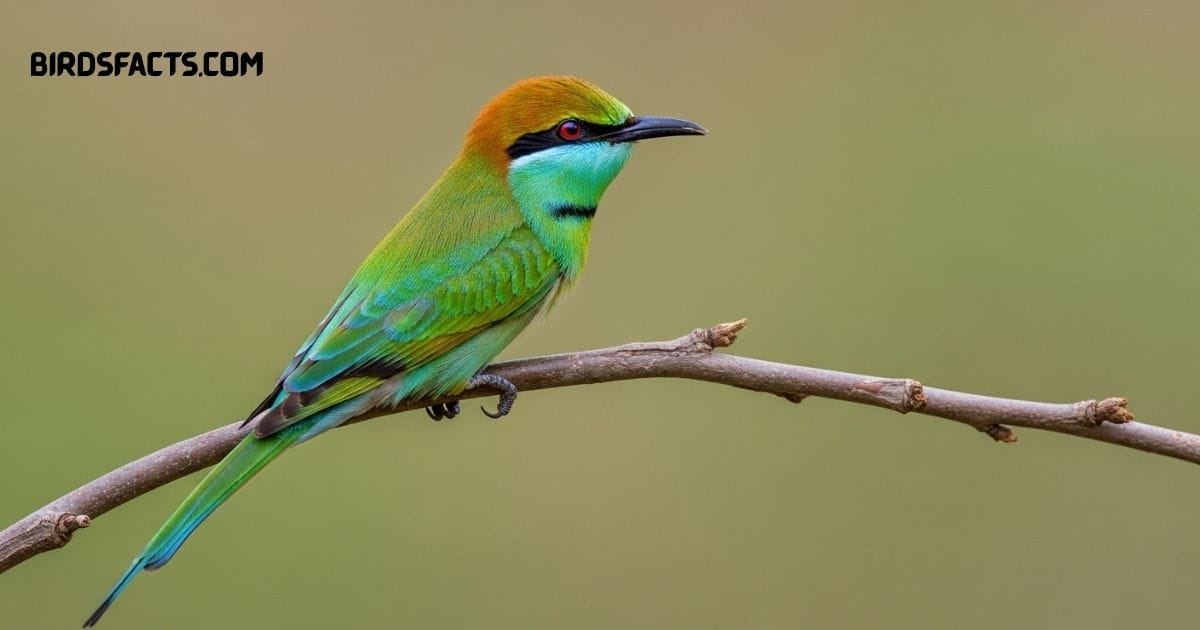
Asian Green Bee-eater with bright green plumage and long tail streamers perched on a branch
The Asian Green Bee-eater Is A Slender Jewel Toned Bird Famous For Its Dazzling Emerald Feathers And Graceful Aerial Displays. True To Its Name It Primarily Feeds On Bees And Dragonflies Catching Them Mid Flight With Impressive Precision. Their Long Central Tail Feathers Add Elegance To Their Already Striking Appearance.
These Birds Thrive Across Asia Often Inhabiting Open Woodlands Fields And Grasslands. They Are Social Creatures Frequently Seen Perching In Small Groups And Their High Pitched Calls Are Easy To Recognize. Their Vibrant Plumage Makes Them One Of The Most Photographed Tropical Green Birds In Their Range.
| Fact | Details |
|---|---|
| Appearance | Slender Body With Bright Emerald Plumage |
| Diet | Hunts Bees And Dragonflies Mid-Air |
| Special Feature | Long Central Tail Streamers |
| Range | Found Across Asia In Semi-Open Habitats |
Blue-Fronted Amazon

Blue-fronted Amazon parrot with green plumage and blue forehead perched on a branch
The Blue Fronted Amazon Is One Of The Most Recognizable Green Birds In The World. Its Body Is Mostly Green But The Brilliant Blue Patch On Its Forehead Sets It Apart. Native To South America Especially In Forests And Savannas This Parrot Is Both Striking And Intelligent.
These Green Birds Are Highly Social And Are Often Kept As Pets Due To Their Strong Ability To Mimic Human Speech. However They Face Conservation Threats From Habitat Loss And The Illegal Pet Trade. In The Wild Their Loud Calls And Playful Nature Make Them A Lively Addition To The Ecosystems They Inhabit.
| Fact | Details |
|---|---|
| Appearance | Green Body With Vivid Blue Forehead |
| Range | Native To South America’s Forests And Savannas |
| Behavior | Known For Intelligence And Mimicry |
| Conservation | Threatened By Illegal Trade |
Budgie

Budgie with green body and yellow head perched on a branch
The Budgerigar Or Simply “Budgie” Is One Of The Most Popular Green Birds Worldwide. While Many Pet Budgies Are Bred In Different Colors The Wild Form Is A Beautiful Green With Black Markings Across The Back. Native To Australia They Thrive In Arid Grasslands Where They Move In Large Noisy Flocks.
Known For Their Playful Personalities Green Birds Like Budgies Can Learn Tricks Mimic Simple Words And Form Close Bonds With Their Human Caretakers. Their Small Size Charming Appearance And Lively Spirit Have Made Them Beloved Companions Across The Globe.
| Fact | Details |
|---|---|
| Appearance | Natural Wild Form Is Green With Black Patterns |
| Range | Native To Australian Grasslands |
| Fun Fact | Extremely Popular As A Pet Bird |
| Behavior | Intelligent Playful And Easy To Train |
Blue-Crowned Conure

Blue-crowned Conure with green body and bright blue head perched on a branch
The Blue Crowned Conure Is A Lively Member Of The Green Birds Family That Stands Out With Its Bright Plumage And Striking Blue Crown. Native To South America It Prefers Semi Open Habitats Where It Can Forage For Fruits Seeds And Blossoms. Its Personality Is As Vibrant As Its Feathers Playful Affectionate And Energetic.
Among The Most Distinctive Green Birds Of Its Region This Conure Is Known For Its Social Nature And Loud Calls. In The Wild They Often Travel In Flocks Filling The Air With Noise And Color While In Captivity They Are Valued For Their Intelligence And Charm. Their Mix Of Emerald And Sapphire Shades Makes Them A True Gem Among Tropical Parrots.
| Fact | Details |
|---|---|
| Appearance | Bright Green Plumage With Blue Crown |
| Range | Native To South America’s Semi-Open Habitats |
| Behavior | Social Affectionate And Playful |
| Call | Known For Loud Distinctive Calls |
Conure
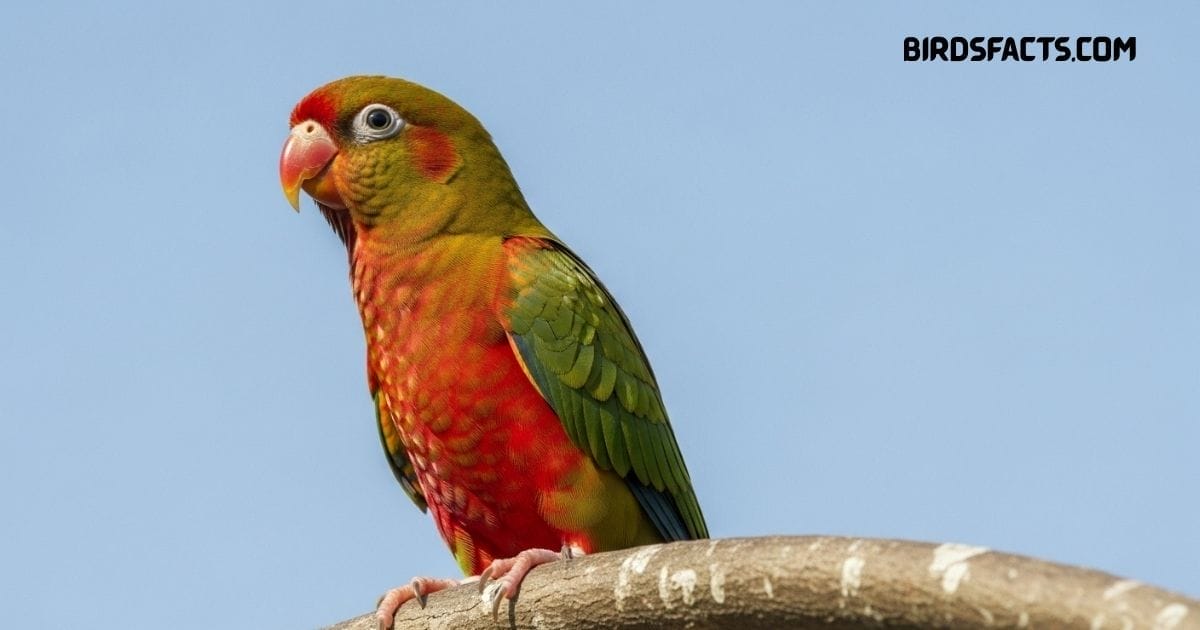
Conure parrot with colorful plumage perched on a branch
The Term Conure Refers To A Group Of Small To Medium Sized Green Birds Many Of Which Display Brilliant Emerald Plumage. These Colorful Parrots Are Widely Distributed Across Central And South America Thriving In Forests Savannas And Even Areas Close To Human Settlements.
Known For Their Curious And Social Nature Green Birds Like Conures Often Travel In Flocks Filling The Air With Cheerful Chatter. They Are Popular As Pets Because Of Their Affectionate Personalities But In The Wild Many Species Face Threats From Deforestation And Habitat Loss Making Conservation Efforts Increasingly Important.
| Fact | Details |
|---|---|
| Appearance | A Group Of Parrots With Predominantly Green Feathers |
| Range | Found Across Central And South America |
| Behavior | Extremely Social And Vocal |
| Conservation | Some Species Threatened By Habitat Loss |
Canary-Winged Parakeet
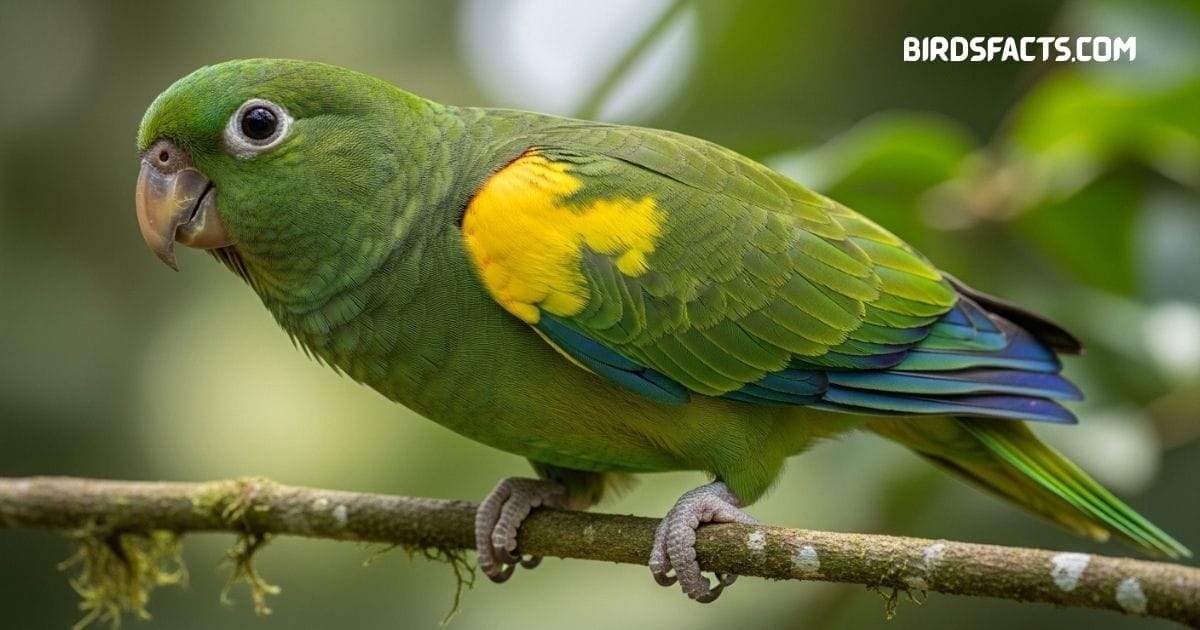
Canary-winged Parakeet with green body and bright yellow wing patches perched on a branch
Also Called The White Winged Parakeet This Small Parrot Is One Of The Most Noticeable Green Birds In The Tropics With Its Bright Plumage And Distinct Yellow Patches On The Wings. Native To South America It’s Known For Forming Lively Flocks That Fill The Sky With Constant Chatter. Interestingly Escaped Populations Have Established Them Selves In Parts Of North America Particularly Florida.
These Green Birds Adapt Well To Urban Environments Feeding On Fruits And Seeds In Gardens And Parks. Their Vibrant Colors And Loud Calls Make Them Easy To Spot Even In Busy Cities. Watching Them Fly Together Adds A Burst Of Color And Joy To Any Landscape Making Them A Favorite Among Bird Watchers.
| Fact | Details |
|---|---|
| Appearance | Green Body With Yellow Wing Patches |
| Range | Native To South America Feral In U.S. Cities |
| Behavior | Active Noisy Flocks In Urban And Wild Areas |
| Adaptation | Highly Adaptable And Resilient Species |
Double Yellow-Headed Amazon Parrot
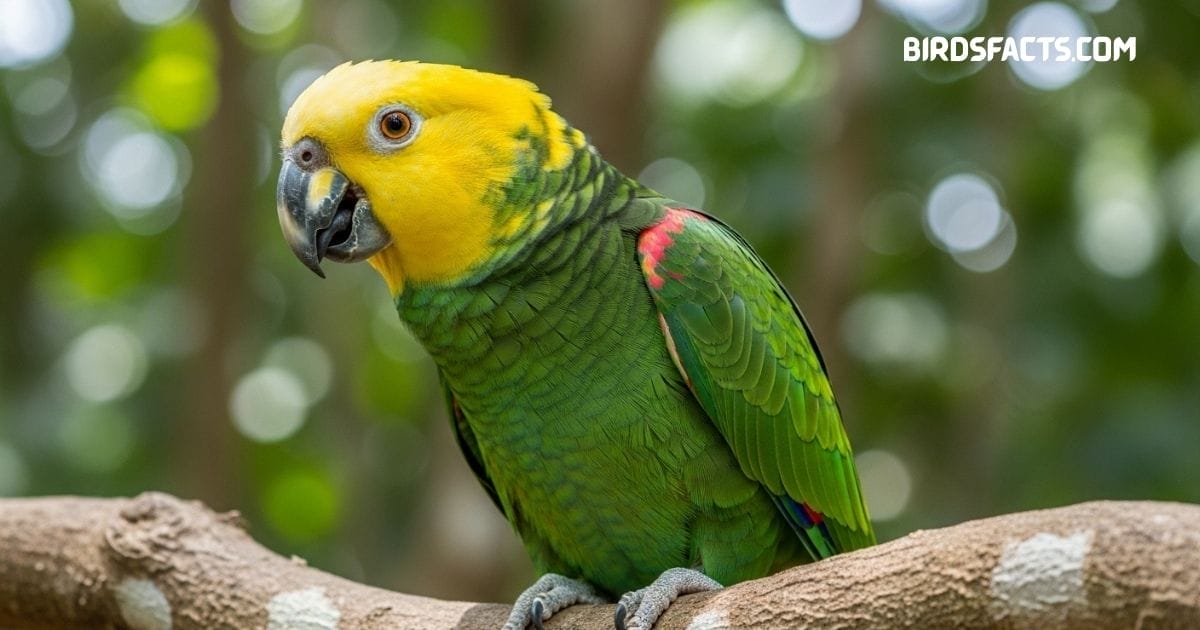
Double Yellow-headed Amazon Parrot with green body and bright yellow head perched on a branch
The Double Yellow Headed Amazon Parrot Is One Of The Most Stunning Green Birds In The World With A Bright Emerald Body And A Radiant Yellow Head That Seems To Glow In The Sunlight. Native To Mexico And Parts Of Central America This Intelligent Parrot Thrives In Tropical Forests And Coastal Mangroves Where It Lives In Noisy Social Groups.
Among The Most Charismatic Green Birds Of Its Region This Species Is Known For Its Ability To Mimic Human Speech And Its Bold Outgoing Nature. Sadly It Is Now Endangered Because Of Illegal Trapping And Habitat Loss. In The Wild Its Powerful Calls Can Be Heard Echoing Through The Forest Long Before The Bird Comes Into View A Reminder Of The Beauty And Fragility Of These Remarkable Parrots.
| Fact | Details |
|---|---|
| Appearance | Green Plumage With Bright Yellow Head |
| Range | Native To Mexico And Central America |
| Ability | Excellent Mimic With Strong Vocal Abilities |
| Conservation | Endangered Due To Illegal Trade And Habitat Destruction |
Eclectus
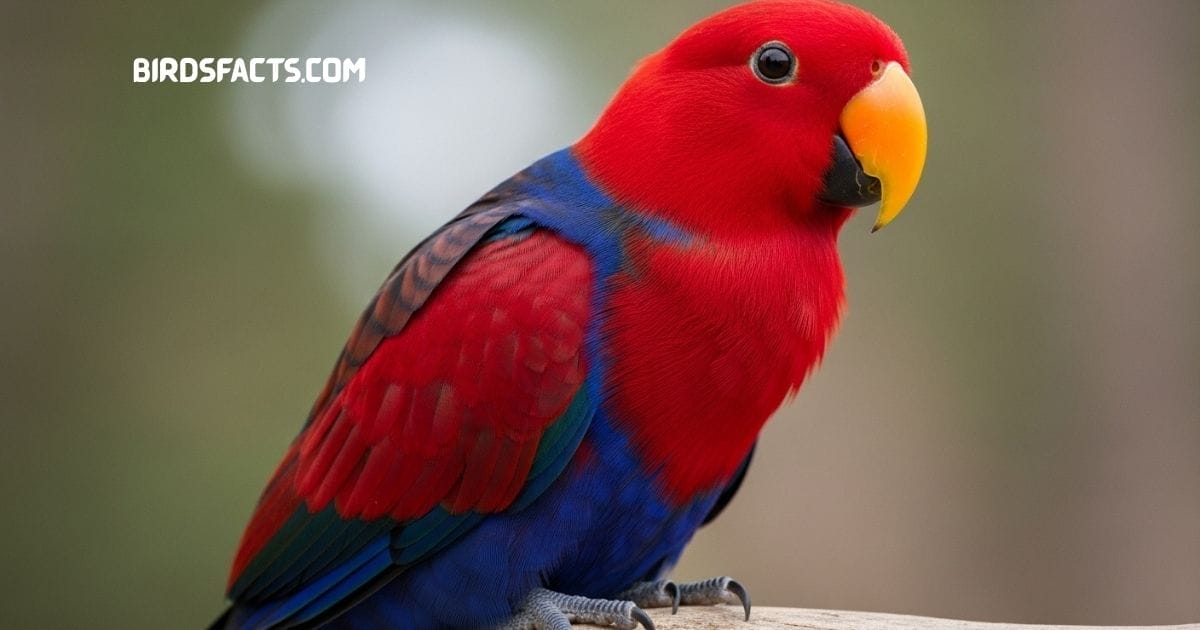
Eclectus Parrot with bright green plumage perched on a branch
The Eclectus Parrot Is One Of The Most Distinctive Green Birds On The Planet Thanks To Its Remarkable Sexual Dimorphism. Males Display Brilliant Emerald Green Plumage With Orange Beaks While Females Are Dressed In Deep Crimson And Royal Purple. This Striking Difference Was So Pronounced That Early Naturalists Once Mistook Them For Two Separate Species.
Among Green Birds The Eclectus Stands Out Not Only For Its Color But Also For Its Gentle Intelligence. Native To The Lush Rainforests Of New Guinea And Surrounding Islands These Parrots Use Their Plumage As Camouflage And Communication. Males Blend Seamlessly Into Green Canopies While Females’ Vivid Colors Signal Territory And Nest Ownership. Their Calm Temperament And Thoughtful Nature Have Made Them Favorites Among Bird Enthusiasts Worldwide.
| Fact | Details |
|---|---|
| Appearance (Male) | Green |
| Appearance (Female) | Red/Purple |
| Range | Native To New Guinea And Surrounding Islands |
| Special Feature | Known For Striking Sexual Dimorphism |
| Behavior | Intelligent And Calm In Captivity |
Fischer’s Lovebird
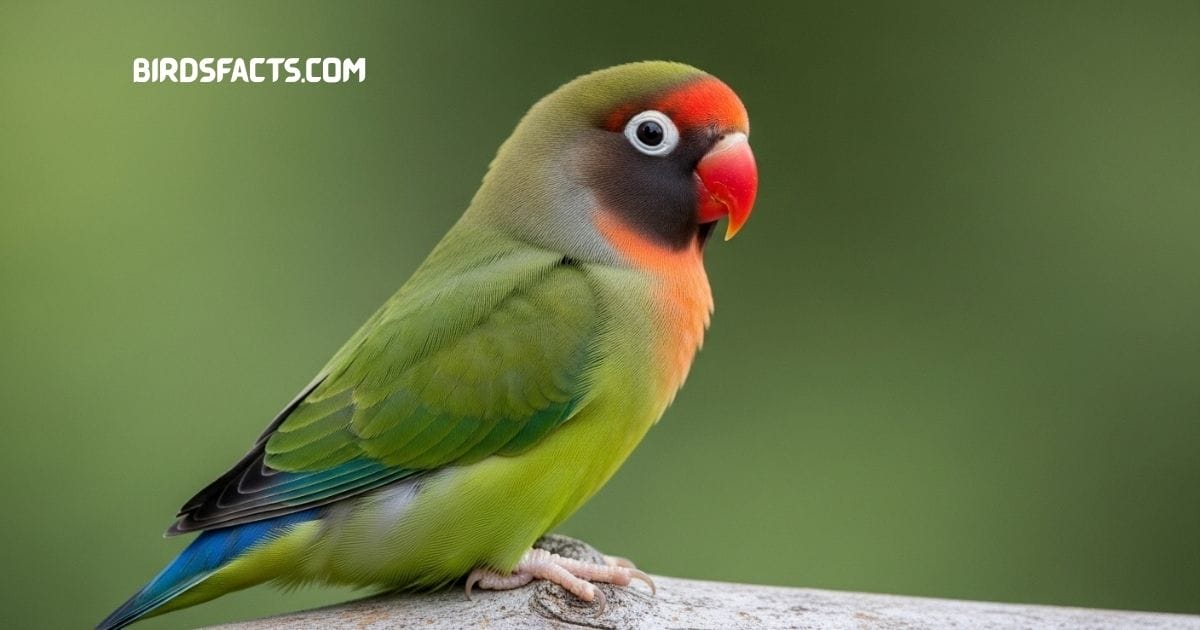
Fischer’s Lovebird with green body and orange face perched on a branch
The Fischer’s Lovebird Is One Of The Most Adorable Green Birds In The World Its Bright Green Body Contrasts Beautifully With Its Orange Face And Blue Rump Creating A Truly Eye Catching Combination. Native To The Grasslands And Woodlands Of Tanzania This Small Parrot Is Known For Its Social And Affectionate Nature Often Seen In Flocks That Fill The Air With Constant Chatter.
Among The Many Green Birds Of Africa Fischer’s Lovebird Stands Out For Its Strong Pair Bonds And Playful Personality. In Captivity It Remains A Favorite For Bird Enthusiasts Because Of Its Loyalty And Expressive Behavior. Whether In The Wild Or As A Pet This Tiny Bird Captures Hearts With Its Vibrant Colors And Loving Disposition.
| Fact | Details |
|---|---|
| Appearance | Small Parrot With Green Body And Orange-Red Face |
| Range | Native To Tanzania In East Africa |
| Behavior | Social Affectionate And Noisy In Groups |
| Fun Fact | Popular In Aviculture Worldwide |
Glistening-green Tanager
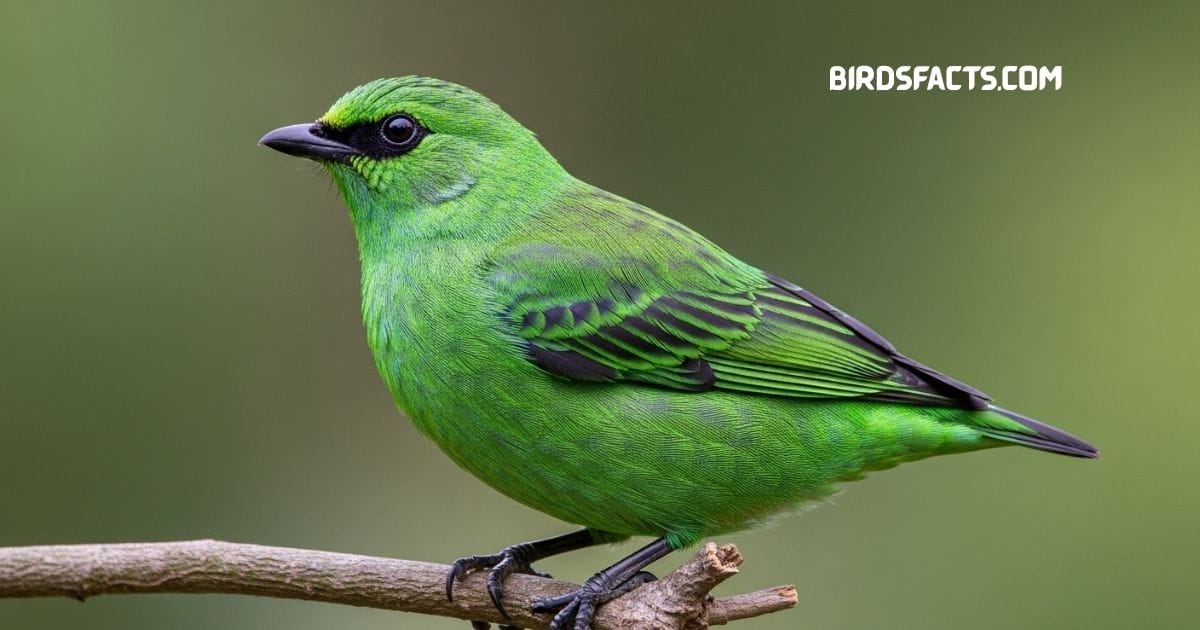
Glistening-green Tanager with bright emerald plumage perched on a branch
The Glistening-green Tanager Is A True Jewel Among Green Birds Looking As If It Has Been Coated In Liquid Emerald. Its Shimmering Jade Feathers Reflect The Moist Light Of The Andean Cloud Forests Of Colombia And Ecuador Giving It A Magical Glow. With Its Vibrant Hue And Compact Build It Stands Out Even In The Lush Greenery Of Its Mountain Home.
Among Green Birds Few Species Are As Radiant Or Elusive As The Glistening-green Tanager. These Birds Live In The Misty Montane Forests Feeding On Fruits Berries And Insects High In The Canopy. For Birdwatchers Spotting One Is Often The Highlight Of A Trip To The Andes A Reward For Patience And A Testament To Nature’s Astonishing Palette.
| Fact | Details |
|---|---|
| Appearance | Brilliant Emerald-Green Plumage |
| Range | Found In Andean Cloud Forests Of Colombia And Ecuador |
| Diet | Feeds On Fruits Berries And Insects |
| Status | Considered Rare And Range-Limited |
Green Kingfisher

Green Kingfisher with green back and white collar perched above water
The Green Kingfisher Is One Of The Most Beautiful Green Birds Found Across Central And South America With Its Glossy Green Feathers White Collar And Reddish Chest Creating A Perfect Balance Of Color. Small Yet Powerful This Bird Perches Silently Over Streams And Rivers Before Diving Swiftly To Catch Tiny Fish With Precision.
Among Green Birds The Green Kingfisher Stands Out For Its Hunting Skills And Elegance. It Thrives In Riparian Habitats Including Mangroves And Slow Flowing Rivers Occasionally Reaching Southern Texas. Its Iridescent Plumage Shimmers In The Sunlight Making It A Favorite Subject For Bird Photographers And A Symbol Of Nature’s Grace Along Tropical Waterways.
| Fact | Details |
|---|---|
| Appearance | Glossy Green Back With White Collar |
| Male Feature | Males Show Reddish Chest Band |
| Range | Found From Central America To South Texas |
| Behavior | Skilled Fisher Diving For Small Prey |
Great Green Macaw

Great Green Macaw with bright green plumage and red forehead perched on a branch
The Great Green Macaw Is One Of The Most Impressive Green Birds On Earth Known For Its Massive Size And Brilliant Plumage. Its Feathers Shine In Vivid Shades Of Emerald Green With Striking Red And Blue Accents Making It A True Giant Of The Tropical Forests In Central And South America. Its Powerful Calls And Expansive Wingspan Make It Impossible To Miss When Flying Over The Canopy.
Among Green Birds The Great Green Macaw Stands As Both A Symbol Of Majesty And A Reminder Of Fragility. It Is Critically Endangered Due To Rapid Deforestation And Illegal Capture For The Pet Trade. Conservation Efforts Across Its Range Aim To Protect Nesting Sites And Reforest Key Areas. For Birdwatchers Witnessing One In The Wild Is A Rare And Emotional Experience A Glimpse Of Nature’s Grandeur And Its Need For Protection.
| Fact | Details |
|---|---|
| Appearance | Large Parrot With Vibrant Green Plumage |
| Range | Native To Central And South American Forests |
| Conservation | Critically Endangered Due To Habitat Loss And Trade |
| Fun Fact | Conservation Icon For Tropical Bird Protection |
Green Jay
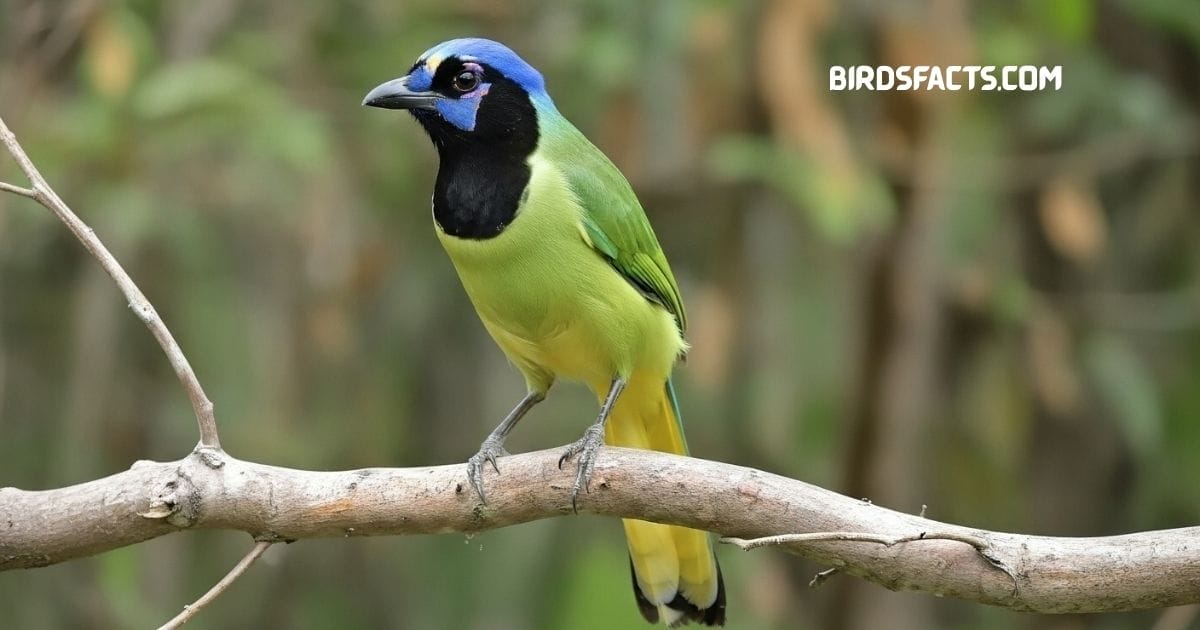
Green Jay with bright green back and blue crown perched on a branch
The Green Jay Is One Of The Most Brilliant Green Birds Found In North And Central America. Its Plumage Blends Shades Of Emerald Green Turquoise And Black Creating A Vivid Living Jewel In The Trees. Found From South Texas Through Mexico Into Central America This Jay Captures Attention With Both Its Colors And Its Playful Personality.
Among Green Birds The Green Jay Stands Out For Its Intelligence And Social Nature. These Birds Live In Noisy Groups Using A Variety Of Calls To Communicate. They Thrive In Semi Open Woodlands And Scrublands Where They Feed On Insects Fruits And Seeds. Their Bright Feathers And Curious Behavior Make Them Unforgettable Companions For Birdwatchers Exploring Warm Forests And Borderland Habitats.
| Fact | Details |
|---|---|
| Appearance | Brilliant Mix Of Green Turquoise And Black |
| Range | Native To South Texas Mexico And Central America |
| Behavior | Intelligent Curious And Social |
| Social Habits | Often Seen In Small Noisy Groups |
Green-breasted Mango
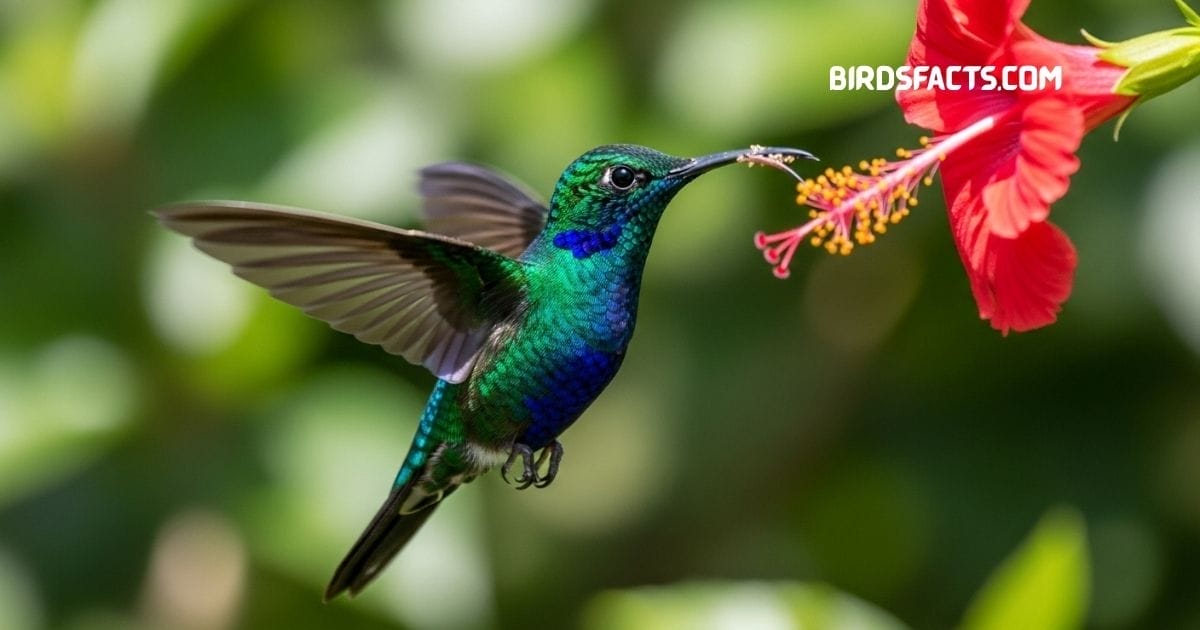
Green-breasted Mango hummingbird with shimmering green body perched on a branch
The Green Breasted Mango Is A Hummingbird Species That Shimmers Like A Gemstone. Its Metallic Green Body Is Complemented By A Striking Blue Black Stripe Down The Breast. Found Across Central And South America It Thrives In Gardens Open Woodlands And Forest Edges Where Flowers Are Abundant. Green Birds Like This One Are Admired For Their Beauty And Grace.
With Rapid Wingbeats It Hovers Grace Fully As It Feeds On Nectar From Tropical Flowers. Bird Photographers Prize This Species For Its Iridescence Which Changes Shades Depending On The Light. It Also Plays An Important Role In Pollination Transferring Pollen As It Feeds. Green Birds Add A Splash Of Color To The Natural World Wherever They Are Found.
| Fact | Details |
|---|---|
| Appearance | Iridescent Green Plumage With Dark Breast Stripe |
| Range | Native To Central And South America |
| Behavior | Frequently Visits Flowering Plants And Gardens |
| Ecological Role | Plays Role In Pollination |
Green Parakeet

Green Parakeet with bright green plumage perched on a branch
The Green Parakeet Is A Lively Bird Often Seen In Flocks That Brighten The Skies With Their Emerald Wings Native To Mexico And Parts Of Central America They Also Occur In South Texas Where Their Raucous Calls Echo Through Cities And Fields Alike. Green Birds Like These Bring Vibrant Color To The Regions They Inhabit.
These Parakeets Are Highly Social And Adaptable Feeding On Seeds Fruits And Crops. Their Adapt Ability Has Allowed Them To Thrive Even In Urban Environments. Green Birds Are Often Spotted Flying Together Creating A Spectacular Visual And Auditory Experience.
| Fact | Details |
|---|---|
| Appearance | Bright Green Plumage With Long Tail |
| Range | Found In Mexico Central America And South Texas |
| Behavior | Extremely Social Traveling In Flocks |
| Adaptation | Adaptable To Urban Environments |
Grass-green Tanager

Grass-green Tanager with bright green plumage perched on a branch
The Grass Green Tanager Is A Spectacular Bird Whose Entire Body Is Cloaked In Vivid Lime Green Feathers. Found In The Humid Montane Forests Of The Andes Particularly In Colombia And Ecuador This Tanager Is A Favorite Among Birdwatchers Due To Its Glowing Coloration. Its Feathers Almost Seem To Shine Against The Misty Backdrop Of The Cloud Forest. Green Birds Like This One Are A True Delight For Nature Enthusiasts.
Diet Mainly Consists Of Fruits Berries And Insects And It Often Forages In Pairs Or Mixed Species Flocks. Its Strong Presence In The Andean Ecosystem Makes It An Important Fruit Disperser Contributing To Forest Regeneration. Green Birds Play A Vital Role In Maintaining The Balance Of Their Natural Habitats.
| Fact | Details |
|---|---|
| Appearance | Bright Green Plumage With Long Tail |
| Range | Found In Mexico Central America And South Texas |
| Behavior | Extremely Social Traveling In Flocks |
| Adaptation | Adaptable To Urban Environments |
Green Heron

Green Heron with dark green back and chestnut neck perched near water
The Green Heron Is A Small Stocky Wading Bird With A Dark Green Back And Wings. Unlike Larger Herons It Often Crouches Low Blending Seamlessly Into Wetland Vegetation. Native To North And Central America It Inhabits Marshes Ponds And Mangrove Swamps. Green Birds Like This One Add Vibrancy To Wetland Landscapes.
What Sets The Green Heron Apart Is Its Intelligence This Bird Is Known To Use Bait Such As Insects Or Twigs To Lure Fish Within Striking Distance. Its Adaptability And Resourcefulness Make It One Of The Most Fascinating Green Toned Birds Of Wetlands. Green Birds Are Often Admired For Their Unique Behaviors And Stunning Plumage.
| Fact | Details |
|---|---|
| Appearance | Small Heron With Dark Green Wings And Back |
| Range | Found In Wetlands Of North And Central America |
| Behavior | Known For Using Bait To Catch Fish |
| Adaptation | Blends Easily Into Aquatic Vegetation |
Green-Cheeked Conure
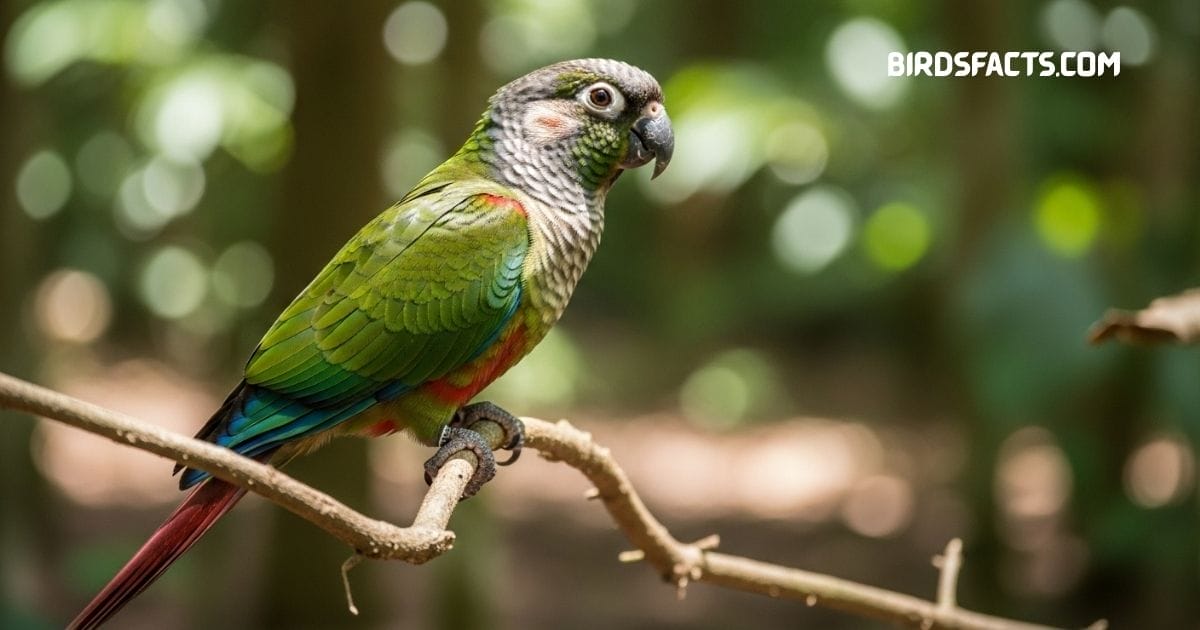
Green-cheeked Conure with green body and maroon tail perched on a branch
The Green Cheeked Conure Is A Small Parrot Full Of Personality With Mostly Green Plumage Accented By A Maroon Tail And Blue Flight Feathers. Native To South America Especially Brazil Bolivia And Argentina These Birds Thrive In Forests And Woodland Edges. Green Birds Like This Conure Are Admired For Their Vibrant Colors And Friendly Nature.
Known For Being Affectionate And Playful They Are Popular In Aviculture. Despite Their Energetic Nature They Tend To Be Quieter Than Many Other Conures Making Them A Good Choice For Pet Owners. In The Wild They Often Gather In Flocks Feeding On Fruits Seeds And Berries. Green Birds Add Joy And Life To Both Natural Habitats And Homes Around The World.
| Fact | Details |
|---|---|
| Appearance | Mostly Green Body With Maroon Tail And Blue Wings |
| Range | Native To South American Forests |
| Behavior | Affectionate Playful And Relatively Quiet |
| Fun Fact | Popular As Companion Birds |
Lineolated Parakeet
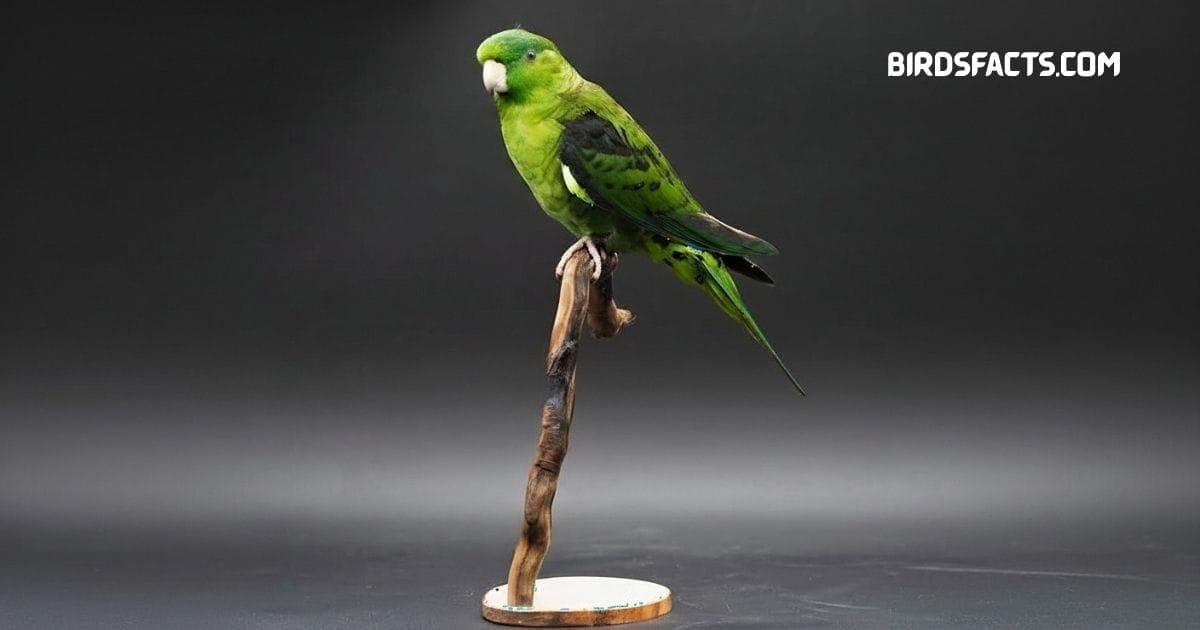
Lineolated Parakeet with green plumage and dark streaks perched on a branch
The Lineolated Parakeet Often Called The “linnie” Is A Small Charming Bird With Green Plumage Marked By Fine Black Streaks. Native To The Mountainous Forests Of Central And South America They Are Adapted To Cooler High Altitude Environments. Green Birds Like These Thrive Beautifully In The Diverse Habitats Of The Americas.
Unlike Many Other Parrots Lineolated Parakeets Are Relatively Quiet And Calm Which Makes Them Beloved As Pets. They Are Social Birds Thriving In Flocks In The Wild Where They Forage For Seeds Fruits And Blossoms. Green Birds Are Cherished For Their Graceful Demeanor And Subtle Yet Captivating Appearance.
| Fact | Details |
|---|---|
| Appearance | Small Parakeet With Green Body And Fine Black Streaks |
| Range | Native To Central And South American Highlands |
| Personality | Calm Quiet And Gentle Personality |
| Fun Fact | Popular Companion Bird |
Meyer’s Parrot
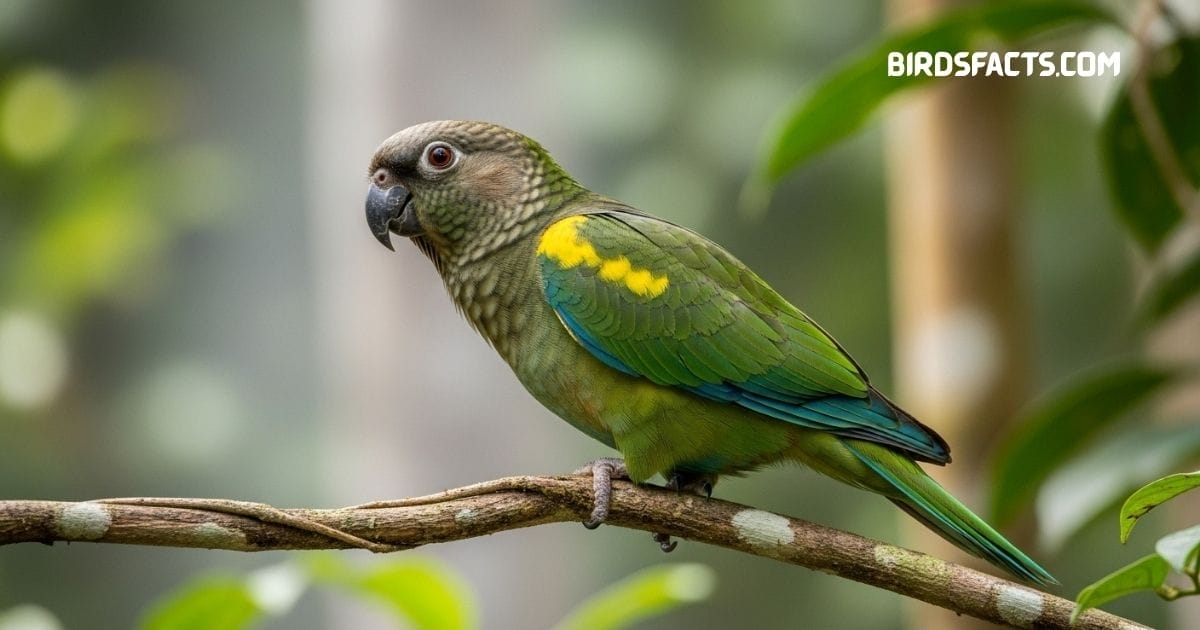
Meyer’s Parrot with gray head and green body perched on a branch
Meyer’s Parrot Is A Small But Vibrant Member Of The Poice phalus Family Native To The Savannas And Woodlands Of Sub Saharan Africa. While Much Of Its Body Is Green It Also Has Yellow Markings On The Wings And Crown Which Add To Its Appeal. Green Birds Like This One Stand Out For Their Subtle Yet Striking Beauty.
These Parrots Are Known For Their Calm Personalities And Are Often Quieter Than Other Parrot Species Making Them Excellent Companion Birds. In The Wild They Live In Small Groups Feeding On Fruits Seeds And Blossoms. Green Birds Are Appreciated Both In Nature And As Pets For Their Gentle Temperament And Brilliant Plumage.
| Fact | Details |
|---|---|
| Appearance | Small Parrot With Green Body And Yellow Patches |
| Range | Native To Sub-Saharan Africa’s Savannas And Woodlands |
| Personality | Calm And Relatively Quiet Personality |
| Fun Fact | Popular In The Pet Trade |
Northern Emerald-Toucanet
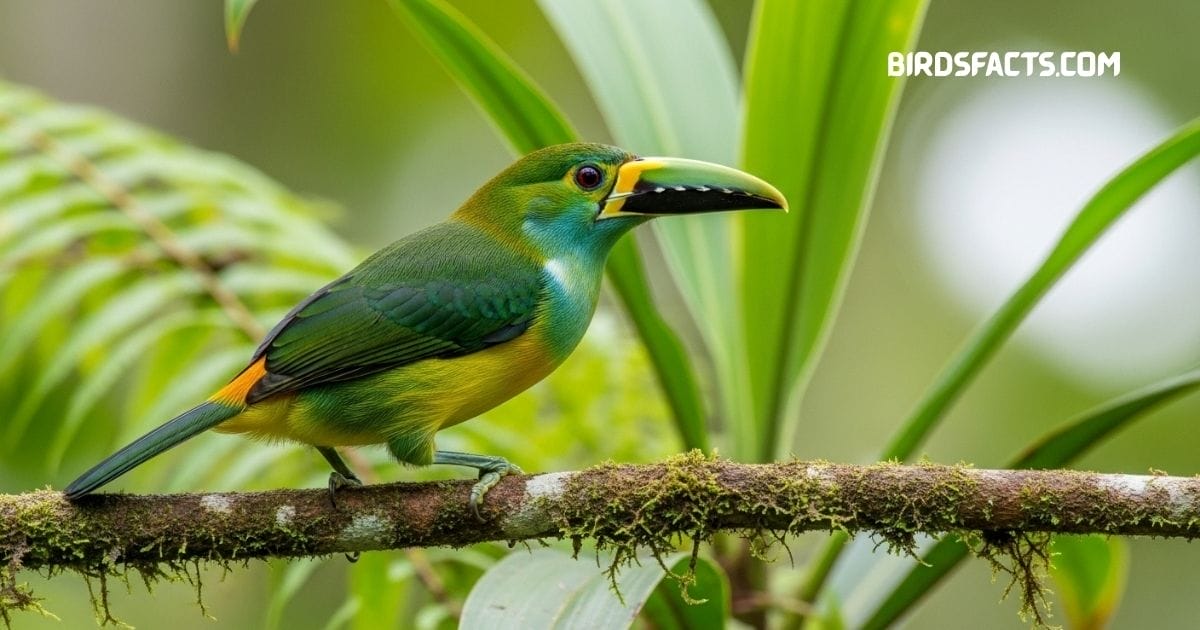
“Northern Emerald-Toucanet colorful green toucan bird”
The Northern Emerald-toucanet Is A Striking Bird Of The Montane Cloud Forests Of Mexico And Central America. Cloaked In Shimmering Green Plumage With A Colorful Bill It’s One Of The Most Stunning Toucans Of Its Size. Its Feathers Help It Blend Seamlessly Into The Dense Forest Canopy. Green Birds Like This Toucanet Are Admired For Their Brilliant Appearance And Vital Role In The Ecosystem.
These Toucanets Feed Mainly On Fruits But Will Also Eat Insects Eggs And Small Vertebrates. Their Bright Colors And Bold Calls Make Them Stand Out Despite Their Camouflage. They Play An Important Ecological Role As Seed Dispersers Helping Maintain The Health Of Tropical Forests. Green Birds Continue To Fascinate Birdwatchers Across The Tropics With Their Beauty And Behavior.
| Fact | Details |
|---|---|
| Appearance | Bright Green Plumage With Colorful Beak |
| Range | Found In Cloud Forests Of Mexico And Central America |
| Diet | Includes Fruits Insects And Small Animals |
| Ecological Role | Key Seed Disperser In Tropical Ecosystems |
Psittacula
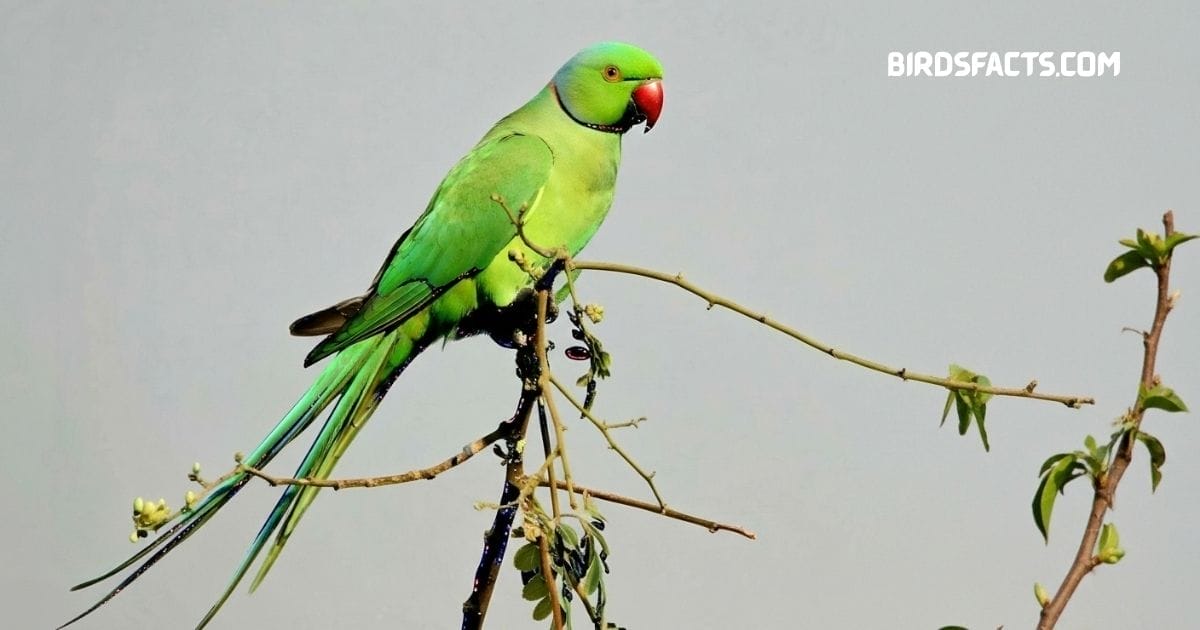
“Psittacula parakeet green parrot perched on branch”
The Genus Psittacula Includes Several Species Of Parakeets Many Of Which Are Predominantly Green. These Birds Are Distributed Across Asia And Africa With The Indian Ring Necked Parakeet Being One Of The Most Famous Members. Their Slender Bodies Long Tails And Bright Plumage Make Them Easily Recognizable. Green Birds Like These Parakeets Bring Vibrancy To Both Wild And Urban Landscapes.
Psittacula Parakeets Are Adapt Able And Thrive In A Variety Of Habitats From Forests To Urban Areas. They Are Intelligent Vocal And Social Birds Often Forming Large Noisy Flocks. Their Adapt Ability Has Helped Them Establish Feral Populations Far From Their Native Ranges. Green Birds From This Genus Continue To Capture Attention For Their Intelligence And Beauty.
| Fact | Details |
|---|---|
| Group | Genus Of Mostly Green Parakeets |
| Range | Distributed Across Asia And Africa |
| Traits | Known For Long Tails And Vocal Nature |
| Examples | Includes Popular Species Like The Indian Ring-Necked Parakeet |
Pionus Parrot
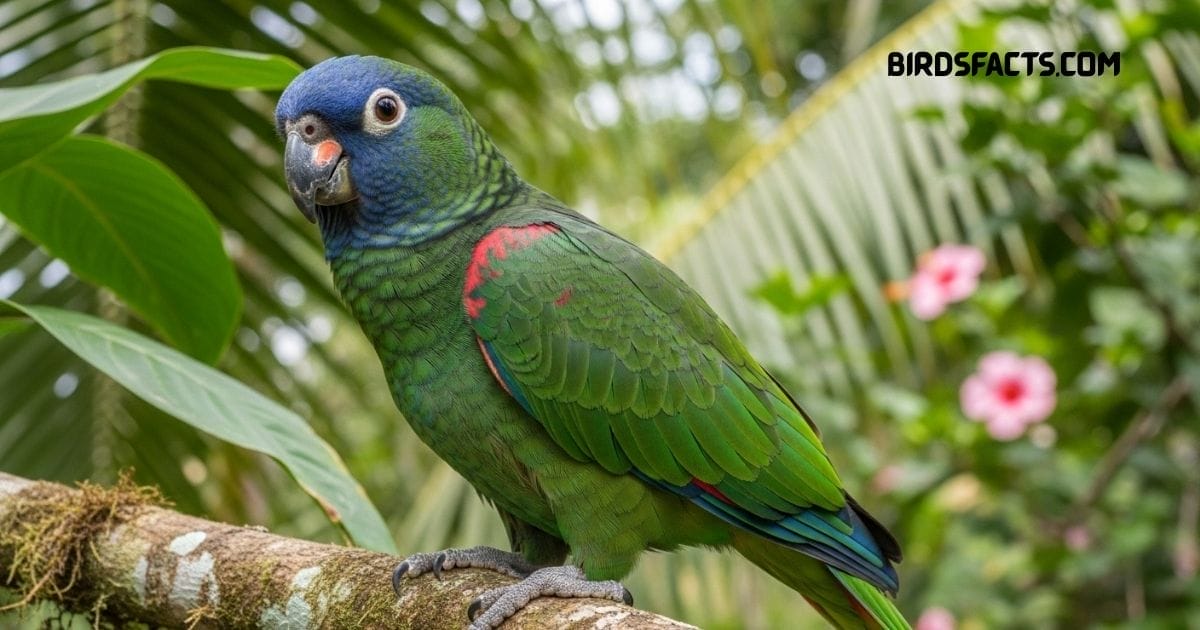
Colorful Pionus Parrot perched on a tree branch
The Pionus Parrot Is A Medium Sized Parrot Family Known For Its Gentle And Quiet Nature. While Plumage Varies Among Species Many Feature Green As Their Dominant Color Accented With Hints Of Blue Red Or Bronze. Native To Central And South America They Are Often Found In Forested Regions And Foothills. Green Birds Like These Parrots Are Admired For Their Subtle Beauty And Calm Temperament.
Unlike Louder Parrots Pionus Are More Reserved Making Them Appealing As Pets. They Are Intelligent Affectionate And Hardy With A Reputation For Being Less Demanding Than Larger Parrots. In The Wild They Feed On Fruits Seeds And Blossoms While Traveling In Flocks. Green Birds Continue To Be Appreciated By Bird Enthusiasts Around The World.
| Fact | Details |
|---|---|
| Appearance | Medium-Sized Parrots With Mainly Green Plumage |
| Range | Native To Central And South America |
| Personality | Known For Calm Quiet Personalities |
| Diet | Feed On Fruits Seeds And Flowers |
Poicephalus
- Poicephalus Parrot perched on a branch
The Poicephalus Genus Includes Several African Parrots Many Of Which Display Rich Green Plumage With Splashes Of Yellow Orange Or Brown. These Birds Are Smaller Compared To Amazon Parrots But Are Known For Their Sturdiness And Adapt Ability. Green Birds Like These Are Admired For Their Resilience And Distinctive Coloration.
Native To Sub Saharan Africa They Thrive In Savannas Forests And Woodlands. Poicephalus Parrots Are Popular In Aviculture Due To Their Intelligence And Manage Able Size. While Not As Flashy As Macaws Their Understated Beauty And Affectionate Personalities Make Them Beloved By Enthusiasts. Green Birds From This Genus Represent Some Of The Most Endearing Parrot Species In Africa.
| Fact | Details |
|---|---|
| Group | Genus Of Small To Medium African Parrots |
| Appearance | Green Plumage With Varied Markings |
| Traits | Intelligent Hardy And Adaptable |
| Fun Fact | Popular As Pets Due To Manageable Size |
Parrotlet
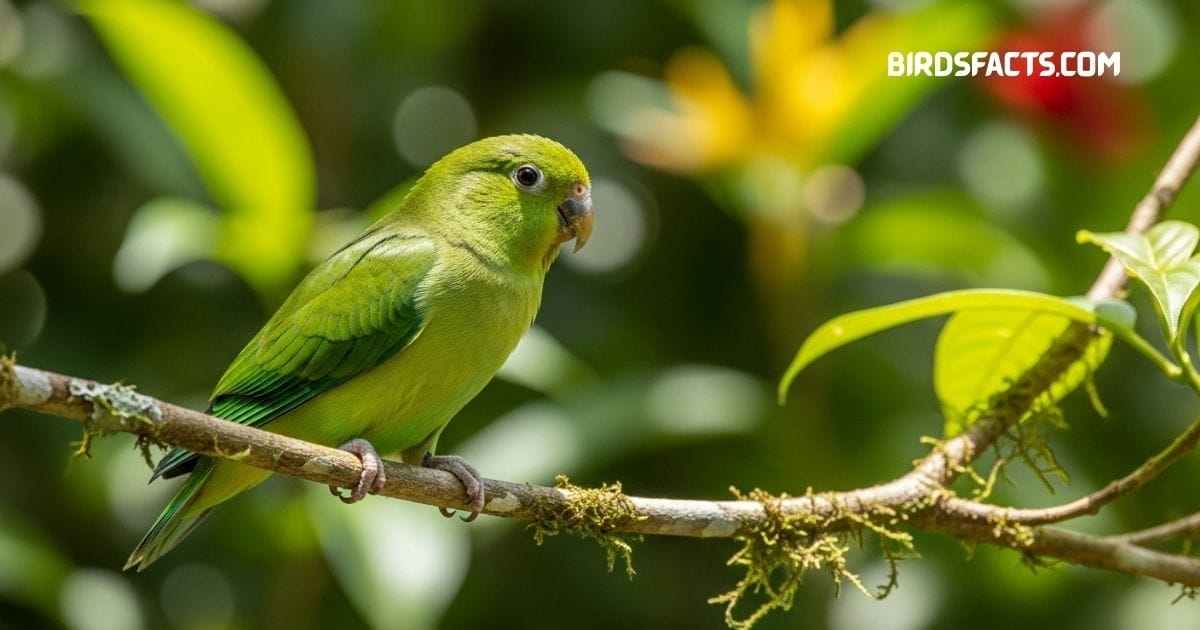
Parrotlet perched on a branch
Parrotlets Are The Tiniest Members Of The Parrot Family But Their Personalities Are Anything But Small. Most Species Are Predominantly Green With Some Displaying Splashes Of Blue Or Yellow. Native To Central And South America They Inhabit Forests Scrublands And Semi Open Habitats. Green Birds Like These Tiny Parrots Bring Energy And Charm To Their Natural Surroundings.
Despite Their Petite Size Parrotlets Are Bold Curious And Highly Intelligent. They Form Close Bonds With Mates And Companions And In Captivity They Require Plenty Of Stimulation. Their Compact Size And Bright Green Feathers Make Them Look Like Miniature Versions Of Larger Parrots. Green Birds Continue To Captivate Bird Lovers With Their Playful Nature And Brilliant Plumage.
| Fact | Details |
|---|---|
| Size | Smallest Members Of The Parrot Family |
| Appearance | Mostly Green Plumage With Blue Or Yellow Accents |
| Range | Native To Central And South America |
| Personality | Bold Curious And Intelligent |
Rosy-Faced Lovebird
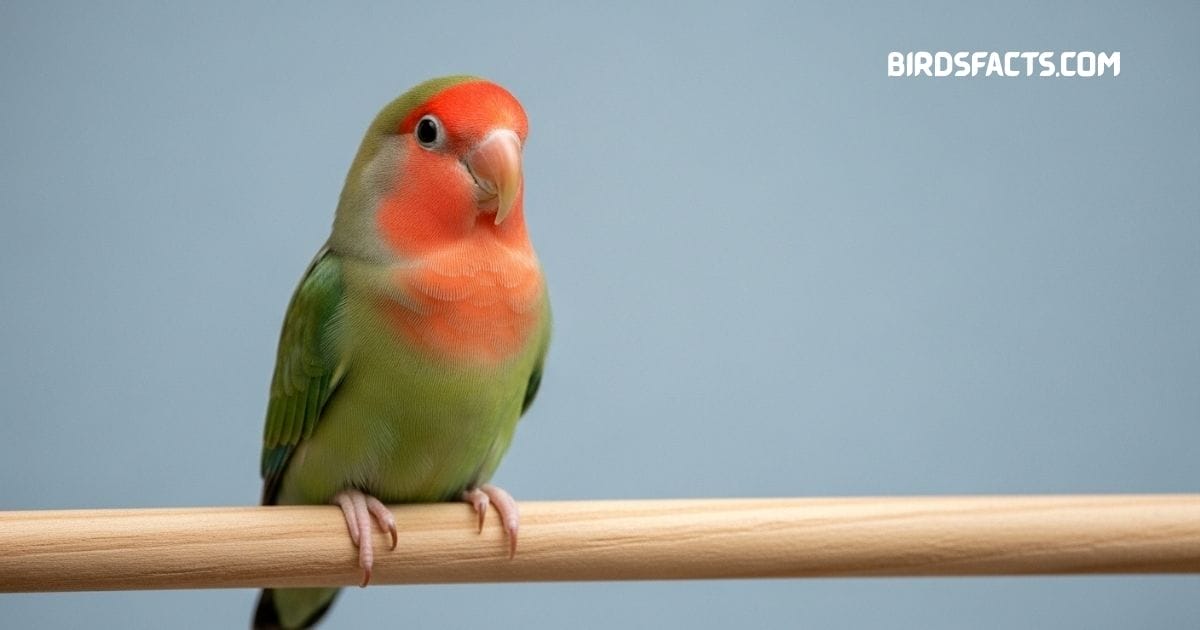
Rosy-Faced Lovebird perched on a branch
The Rosy Faced Lovebird Also Called The Peach Faced Love Bird Is A Small Parrot With A Bright Green Body And A Rosy Pink Face. Native To Arid Regions Of Southwestern Africa Particularly Namibia And Angola These Birds Bring A Splash Of Color To Dry Land Scapes. Green Birds Like These Lovebirds Are Known For Their Vibrant Appearance And Social Nature.
They Are Highly Social Often Found In Noisy Flocks And Form Strong Pair Bonds That Live Up To Their Name. Escaped Populations Have Also Established Themselves In Urban Areas Such As Phoenix Arizona Where They Thrive In Palm Trees. Their Affectionate And Lively Personalities Make Them A Favorite In Aviculture. Green Birds Continue To Delight Bird Enthusiasts With Their Beauty And Endearing Behavior.
| Fact | Details |
|---|---|
| Appearance | Green Plumage With Rosy-Pink Face |
| Range | Native To Southwestern Africa Feral In Phoenix USA |
| Behavior | Strong Pair Bonds And Highly Social |
| Fun Fact | Popular And Hardy Pet Species |
Senegal Parrot

Senegal Parrot perched on a branch
The Senegal Parrot Is A Compact And Charming Parrot Native To West Africa. Its Plumage Features A Gray Head Green Back And Bright Yellow To Orange Chest Giving It A Unique Tricolor Look. Unlike Many Parrots Senegals Are Known For Being Relatively Quiet Which Adds To Their Popularity As Pets. Green Birds Like The Senegal Parrot Stand Out For Their Distinct Colors And Calm Nature.
In The Wild They Inhabit Savannas And Wood Lands Where They Feed On Seeds Nuts And Fruits. They Are Intelligent And Affectionate Birds That Bond Closely With Their Owners In Captivity. Their Manage Able Size And Gentle Personality Make Them One Of The Most Beloved Small Parrots. Green Birds From This Region Add Vibrancy And Life To The African Landscape.
| Fact | Details |
|---|---|
| Appearance | Distinctive Green Yellow/Orange And Gray Plumage |
| Range | Native To West African Savannas And Woodlands |
| Personality | Intelligent Affectionate And Relatively Quiet |
| Fun Fact | Popular Pet Parrot Due To Calm Nature |
White-eyed Parakeet
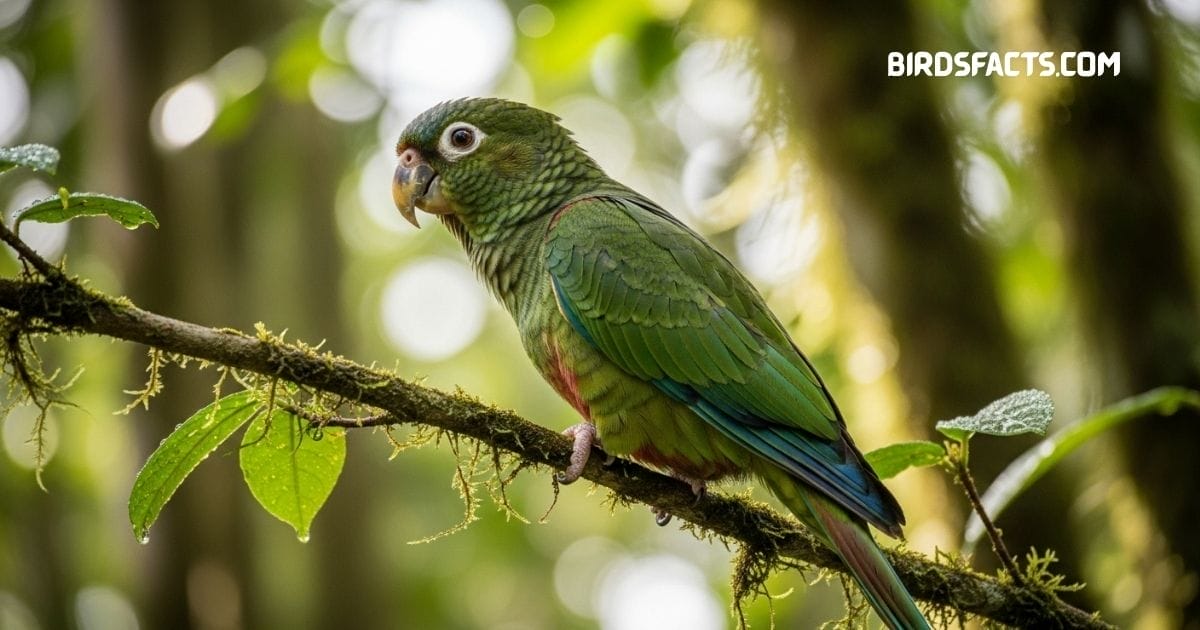
White-Eyed Parakeet perched on a tree branch
The White Eyed Parakeet Is A Lively Green Parrot Distinguished By The Pale Ring Around Its Eye. Its Plumage Is A Rich Green With Occasional Red Patches On The Wings Giving It Extra Charm. Native To South America Particularly Brazil Paraguay And Argentina These Birds Thrive In Forests Savannas And Even Urban Areas. Green Birds Like These Are A Joy To Watch In Their Natural Habitats.
Highly Social They Often Gather In Large Noisy Flocks That Can Number In The Hundreds. Their Adapt Ability Has Allowed Them To Flourish Despite Habitat Changes Although They Are Still Affected By Deforestation In Some Regions. Their Energetic Flights And Constant Chatter Make Them Un Mistak Able In The Wild. Green Birds Continue To Inspire Birdwatchers With Their Beauty And Spirit.
| Fact | Details |
|---|---|
| Appearance | Rich Green Plumage With Red Wing Patches |
| Range | Native To South America Especially Brazil And Argentina |
| Field Mark | Distinct Pale Ring Around The Eyes |
| Behavior | Travels In Large Noisy Flocks |
Yellow-Naped Amazon Parrot
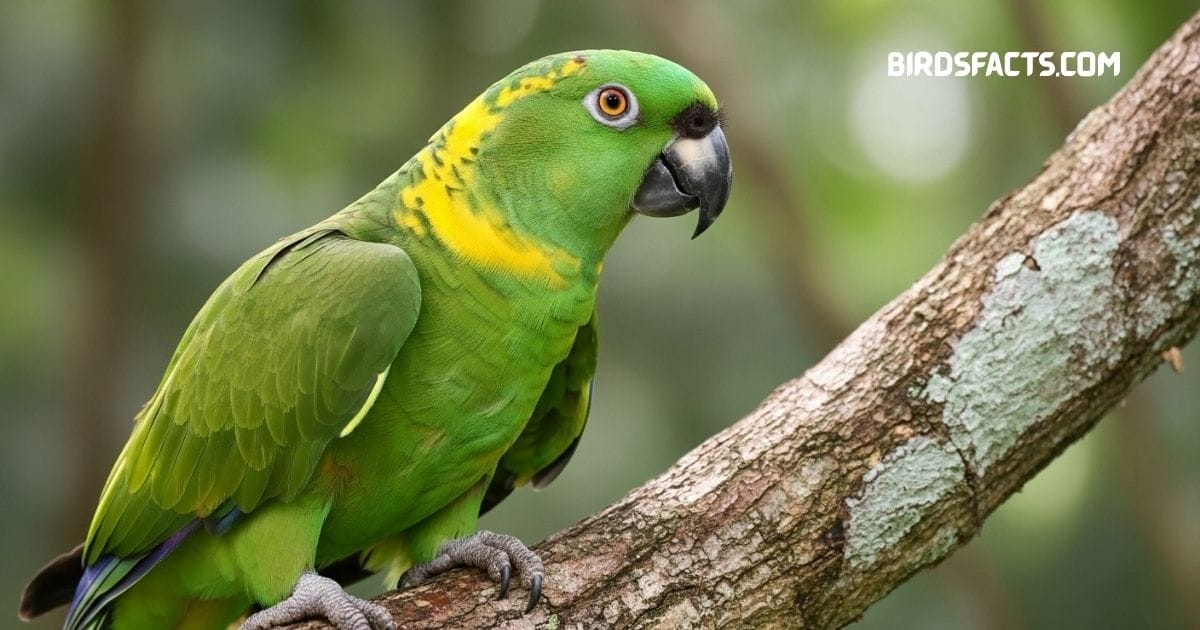
Yellow-Naped Amazon Parrot perched on a branch
The Yellow Naped Amazon Parrot Is A Striking Species With A Green Body And A Bright Yellow Patch On The Nape Of Its Neck. Native To Central America It Inhabits Dry Forests Mangroves And Agricultural Landscapes. Its Intelligence And Exceptional Mimicry Have Made It One Of The Most Popular Amazon Parrots In Avi culture. Green Birds Like This Parrot Are Known For Their Vibrant Plumage And Remarkable Intelligence.
Sadly This Species Is En Dangered Due To Habitat Destruction And Illegal Capture For The Pet Trade. In The Wild Their Loud Calls Echo Through Forests And They Are Often Seen In Pairs Or Small Groups. Conservation Efforts Are Un Derway To Protect Remaining Populations And Preserve Their Habitats. Green Birds Serve As A Reminder Of The Importance Of Protecting Wildlife Diversity.
| Fact | Details |
|---|---|
| Appearance | Green Plumage With Yellow Patch On The Nape |
| Range | Native To Central America’s Dry Forests And Mangroves |
| Ability | Highly Intelligent With Strong Mimicking Ability |
| Conservation | Endangered Due To Illegal Trade And Habitat Loss |
What Are Those Green Birds Called?
They’re Often Parrots Parakeets Tanagers Or Jays With Species Like The Green Jay And Great Green Macaw Being Among The Most Famous.
Are There Any Green Birds In North America?
Yes Species Like The Green Jay In Texas And The Green Heron In Wetlands Are Found In North America.
What Kind Of Small Bird Is Green?
Small Green Birds Include Budgies Parrotlets And Lovebirds All Of Which Are Colorful And Lively.
Are Green Birds Good Pets?
Yes Many Green Birds Such As Budgies Conures And Lovebirds Make Excellent Pets Due To Their Playful And Affectionate Personalities.
What Does It Mean When You See A Green Bird?
Culturally Spotting A Green Bird Often Symbolizes Growth Renewal And Harmony With Nature.
Conclusion
From The Shimmering Resplendent Quetzal Of The Cloud Forests To The Play Ful Budgie Found In Homes Worldwide Green Birds Dazzle Us With Their Variety Beauty And Ecological Importance. Their Emerald Plumage Serves Many Roles From Camouflage To Court Ship And Connects Us To Some Of The Planet’s Most Breathtaking Natural Landscapes.
Yet Many Of These Species Face Serious Threats Including Deforestation Illegal Trade And Climate Change. Protecting These Green Birds Isn’t Just About Preserving Their Beauty It’s About Safeguarding Ecosystems Where They Play Vital Roles As Pollinators Seed Dis Persers And Insect Controllers.

